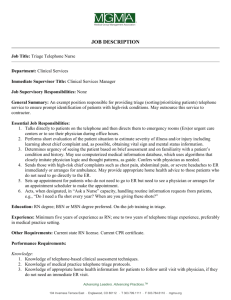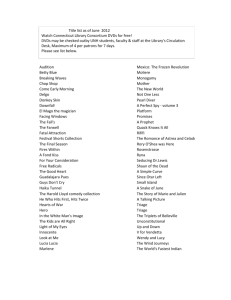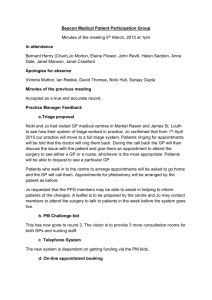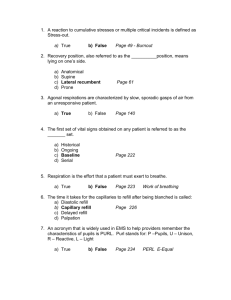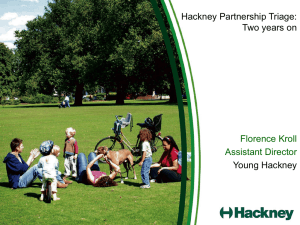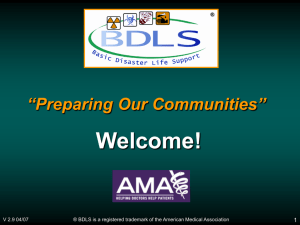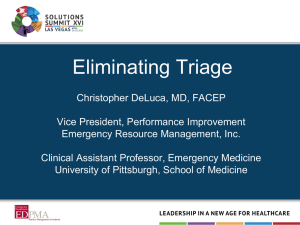Beyond Red, Yellow, Green and Black: MCI Triage
advertisement
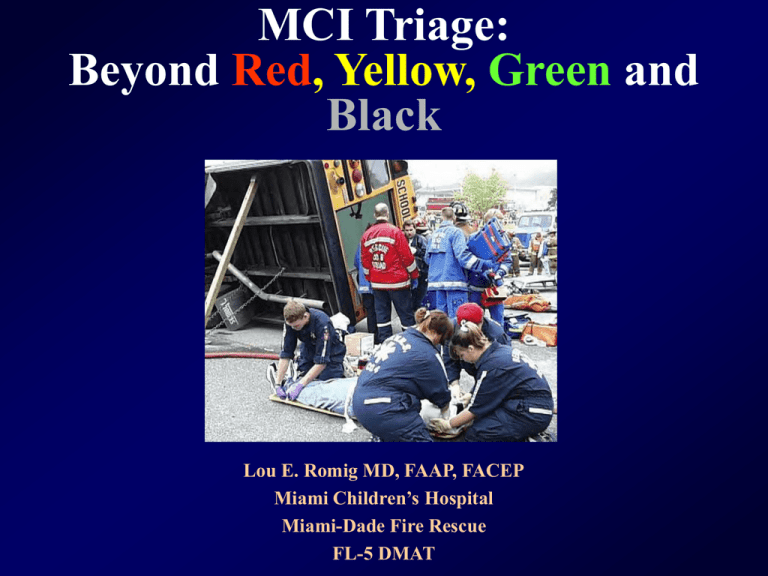
MCI Triage: Beyond Red, Yellow, Green and Black Lou E. Romig MD, FAAP, FACEP Miami Children’s Hospital Miami-Dade Fire Rescue FL-5 DMAT Topics What is Triage? Triage Categories Triage Tools What is Triage? “Triage” means “to sort” Looks at medical needs and urgency of each individual patient Sorting based on limited data acquisition Also must consider resource availability Military vs. Civilian Triage Priority is to get as many soldiers back into action as possible. Priority is to maximize survival of the greatest number of victims. Military vs. Civilian Triage Military model Those with the least serious wounds may be the first treatment priority Civilian model Those with the most serious but realistically salvageable injuries are treated first Military vs. Civilian Triage In both models, victims with clearly lethal injuries or those who are unlikely to survive even with extensive resource application are treated as the lowest priority. Ethical Justification This is one of the few places where a "utilitarian rule" governs medicine: the greater good of the greater number rather than the particular good of the patient at hand. This rule is justified only because of the clear necessity of general public welfare in a crisis. A. Jonsen and K. Edwards, “Resource Allocation” in Ethics in Medicine, Univ. of Washington School of Medicine, http://eduserv.hscer.washington.edu/bioethics/topics/resall.html Why Should Responders Care About Good Triage? Provides a way to draw organization out of chaos Helps to get care to those who need it and will benefit from it the most Helps in resource allocation Provides an objective framework for stressful and emotional decisions Why are Resources Important in Triage? Disaster is commonly defined as an incident in which patient care needs overwhelm local response resources. Daily emergency care is not usually constrained by resource availability. Abundant resources relative to demand (P = Patient) Do the best for each individual Resources challenged Do the best for each individual (P = Patient) Resources Do the greatest good overwhelmed for the greatest number (P = Patient) Daily Emergencies Do the best for each individual. Disaster Settings Do the greatest good for the greatest number. Maximize survival. Triage is a dynamic process and is usually done more than once. Primary Disaster Triage Goal: to sort patients based on probable needs for immediate care. Also to recognize futility. Assumptions: Medical needs outstrip immediately available resources Additional resources will become available with time Primary Disaster Triage Triage based on physiology How well the patient is able to utilize their own resources to deal with their injuries Which conditions will benefit the most from the expenditure of limited resources Primary Disaster Triage The most commonly used adult tool in the US and Canada is the START tool. The only recognized pediatric MCI primary triage tool used in the US and Canada is the JumpSTART tool. Other tools exist but are less oriented to mass casualties than triaging smaller numbers of (adult) trauma patients. Basic Disaster Life Support National Disaster Life Support Education Consortium, via Medical College of Georgia’s Center of Operational Medicine Endorsed by the American Medical Association Disaster Medicine Online University (www.dmou.org) Basic Disaster Life Support MASS Triage Move Assess Sort Send ? Assessment guidelines ? Pediatric considerations The Best Tool? No MCI primary triage tool has been validated by outcome data. Wiseman DB, Ellenbogen R, Shaffrey CI. “Triage for the Neurosurgeon”, Neurosurg Focus 12(3), 2002. Available on the Internet at www.medscape.com/viewarticle/431314 Secondary Disaster Triage Goal: to best match patients’ current and anticipated needs with available resources. Incorporates: A reassessment of physiology An assessment of physical injuries Initial treatment and assessment of patient response Further knowledge of resource availability Secondary Triage Tools There is no widely recognized tool in the US that addresses secondary MCI triage. California “Medical Disaster Response” course’s SAVE tool (Secondary Assessment of Victim Endpoint) Many EMS systems use local trauma center triage criteria. NATO Guidelines Red Airway obstruction, cardiorespiratory failure, significant external hemorrhage, shock, sucking chest wound, burns of face or neck Yellow Open thoracic wound, penetrating abdominal wound, severe eye injury, avascular limb, fractures, significant burns other than face, neck or perineum NATO Guidelines Green Minor lacerations, contusions, sprains, superficial burns, partial-thickness burns of < 20% BSA Black Head injury with GCS<8, burns >85% BSA, multisystem trauma, signs of impending death Burkle FM, Orebaugh S, Barendse BR, Ann Emerg Med 23:742-747, 1994 Secondary Triage Tools Goal is to distinguish between: Victims needing life-saving treatment that can only be provided in a hospital setting. Victims needing life-saving treatment initially available on scene. Victims with moderate non-lifethreatening injuries, at risk for delayed complications. Victims with minor injuries. Tertiary Disaster Triage Goal: to optimize individual outcome Incorporates: Sophisticated assessment and treatment Further assessment of available medical resources Determination of best venue for definitive care Primary Triage Secondary Triage Tertiary Triage MCI Triage: Key Points Resources and patient numbers and acuity are limiting factors. Must be dynamic, responsive to changes in both resources and patient needs. There is currently no civilian MCI triage system that has been validated by outcome data. Triage Categories Triage Categories Red: Life-threatening but treatable injuries requiring rapid medical attention Yellow: Potentially serious injuries, but are stable enough to wait a short while for medical treatment Triage Categories Green: Minor injuries that can wait for longer periods of time for treatment Black: Dead or still with life signs but injuries are incompatible with survival in austere conditions Triage Tools START Simple Triage And Rapid Treatment Developed jointly by Newport Beach (CA) Fire and Marine Dept. and Hoag Hospital Gold standard for field adult multiple casualty (MCI) triage in the US and numerous countries around the world START Utilizes the same four triage categories Used for Primary Triage www.start-triage.com START Triage RESPIRATIONS PERFUSION NO Over 30/min Position Airway NO Dead or Expectant Under 30/min YES YES Immediate Immediate Cap refill > 2 sec Control Bleeding Immediate Cap refill < 2 sec. MENTAL STATUS Failure to follow simple commands Can follow simple commands Immediate Delayed START: Step 1 Triage officer announces that all patients that can walk should get up and walk to a designated area for eventual secondary triage. All ambulatory patients are initially tagged as Green. START: Step 2 Triage officer assesses patients in the order in which they are encountered Assess for presence or absence of spontaneous respirations If breathing, move to Step 3 If apneic, open airway If patient remains apneic, tag as Black If patient starts breathing, tag as Red START: Step 3 Assess respiratory rate If ≤30, proceed to Step 4 If 30, tag patient as Red START: Step 4 Assess capillary refill If ≤ 2 seconds, move to Step 5 If 2 seconds, tag as Red START: Step 5 Assess mental status If able to obey commands, tag as Yellow If unable to obey commands, tag as Red Mnemonic R P M 30 2 Can do JumpSTART Pediatric MCI Triage Developed by Lou Romig MD, FAAP, FACEP Now in widespread use throughout the US and Canada Being taught in Japan, Germany, Switzerland, the Dominican Republic, Africa, Polynesia JumpSTART Pediatric MCI Triage Recognized by the US National Disaster Medical System Published in Brady’s Prehospital Emergency Care, 7th ed. Published in APLS course www.jumpstarttriage.com Patients who are able to walk are assumed to have stable, wellcompensated physiology, regardless of the nature of their injuries or illness. Secondary Triage All green patients must be individually assessed in secondary triage. Assess physiology Assess injuries Assess probability of deterioration Assess needs vs. resource availability Secondary Triage Some children may be carried to the green area by others. They have not proven their physiologic stability by performing the complex act of walking. These children should be assessed first among all those in the green area. Position the upper airway of the apneic child. If they start to breathe, tag them as If the child doesn’t start breathing with upper airway opening, feel for a pulse. If no pulse is palpable, tag the patient as If the patient has a palpable pulse, give 5 mouthto-barrier breaths to open the lower airways. Tag as below, depending on response to ventilations. DO NOT CONTINUE TO VENTILATE THE PATIENT. RESUME TRIAGE DUTIES. Assess the respiratory rate of the spontaneously breathing child. Move on to next assessment if respiratory rate is 15-45 breaths/minute. If respiratory rate is <15 or >45, tag the patient as If the child’s pulse is palpable, move on to the next assessment. If no palpable pulse, tag the patient as If patient is inappropriately responsive to pain, posturing, or unresponsive, tag as If patient is alert, responds to voice or appropriately responds to pain, tag as Modification for Nonambulatory Children Children developmentally unable to walk due to young age or developmental delay Children with chronic disabilities that prevent them from walking Modification for Nonambulatory Children For nonambulatory children, assess using the JumpSTART algorithm. If pt meets any red criteria tag as Modification for Nonambulatory Children If patient meets yellow criteria and has significant external signs of injury, tag as If patient meets yellow criteria and has no significant external signs of injury, tag as What about WMD? There is no widely recognized civilian MCI triage tool used in the US for any of the NRBC agents. WMD Triage Challenges Any triage model for WMD must consider decontamination: Who goes first? At what stage does triage take place? Difficulty of conducting patient assessment and care with responders in protective gear. WMD Triage Challenges Agents of attack may be mixed. How do you triage victims who have injuries from a conventional attack in addition to a chemical or radiological/nuclear exposure? WMD Triage Challenges Biological agents may impact field triage mostly in choice of destination facility (quarantine hospital). Patterns of EMS calls may assist in identification of a occult biological agent attack or a natural epidemic Example biosurveillance tool is the First Watch program http://www.stoutsolutions.com/firstwatch WMD Triage Challenges Some agents cause “toxindromes” that allow for prediction of outcome based on presenting symptoms and signs. Agent-specific triage is dependent upon identification or strong suspicion of the agent’s use. Very difficult to train and maintain readiness with multiple agent-specific triage schemes. Chemical Toxindrome Examples Nerve agent Red: severe distress, seizure, signs in two or more systems (neuromuscular, GI, respiratory – excluding eyes and nose) Black: pulseless or apneic, unless intensive resources are available Chemical Toxindrome Examples Phosgene and vesicants Red: moderate to severe respiratory distress, only when intensive resources are immediately available Black: burns >50% BSA from liquid exposure, signs of more than minimal pulmonary involvement, when intensive resources are not available Chemical Toxindrome Examples Cyanide Red: active seizure or recent onset of apnea with preserved circulation Black: no palpable pulse Sidell FR, “Triage of Chemical Casualties” Chapter 14 in Medical Aspects of Chemical and Biological Warfare, available on the Internet at http://www.bordeninstitute.army.mil/cwbw/Ch14.pdf Key Points about MCI Triage Anything that can help organize the response to an MCI is a good thing. MCI triage is different than daily triage, in both field and ED settings. Resource availability is the limiting factor to consider in MCI triage. Key Points about MCI Triage In order for MCI triage to work toward its goal, all victims must have equal importance at the time of primary triage. No patient group can receive special consideration other than that dictated by their physiology. This includes children! Key Points about MCI Triage Disaster research agendas should include efforts to validate and improve existing triage tools. Key Points about MCI Triage MCI triage will never be logistically, intellectually, or emotionally easy… but we must be prepared to do it using the best of our knowledge and abilities. Thank You! For more information on JumpSTART please go to: www.jumpstarttriage.com You can contact Dr. Romig at: LouRomig@jumpstarttriage.com or louromig@bellsouth.net


